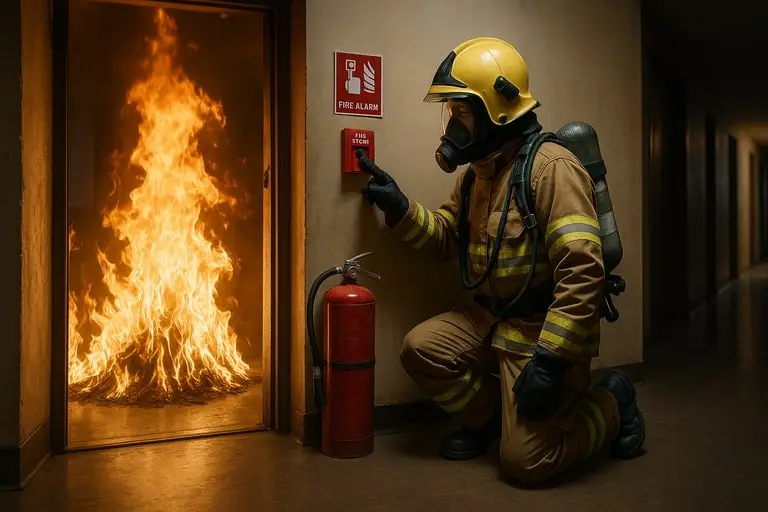Fire safety in buildings is one of the most defining priorities in construction because the way structures are designed and built directly determines how they will perform in an emergency. From the perspective of both human safety and economic resilience, incorporating fire-conscious strategies is no longer a matter of simply following regulations but of actively creating spaces that safeguard lives. In high-density urban environments, this responsibility becomes even greater as populations grow and architectural designs become more complex. The central principle is that every decision, whether in material selection or layout planning, influences how well a building can resist, contain, and withstand fire events.
One of the main pillars of building fire safety lies in understanding how fire behaves within enclosed spaces. Flames spread differently depending on ventilation, fuel availability, and building geometry. Modern fire-safe construction emphasizes compartmentalization, using walls and fire doors to slow down the movement of heat and smoke. This strategy buys valuable time for evacuation and reduces the risk of structural collapse. Such designs highlight the difference between buildings that merely comply with codes and those that are engineered for true resilience.
Selecting fire-resistant materials has become one of the most important steps toward safer buildings. Reinforced concrete, treated steel, and innovative composites demonstrate how engineering advancements can create structures capable of resisting high heat without losing strength. Even timber, long regarded as risky, has seen progress through technologies like cross-laminated timber that can meet fire safety benchmarks. The correct application of coatings and insulations ensures that surfaces exposed to flames perform as barriers rather than accelerants. This material science evolution allows architects to merge creativity with responsibility.
Beyond materials, fire safety in modern buildings requires integrated detection and suppression systems. Intelligent smoke detectors and automated sprinklers connected to centralized systems ensure rapid responses that human intervention alone cannot achieve. As urban environments grow more interconnected, these technologies form part of broader smart-building ecosystems where sensors monitor air quality, energy use, and fire risk simultaneously. This integration ensures not only protection during emergencies but also continuous risk management.
Evacuation design remains central to fire safety in buildings. A structure’s brilliance in aesthetics or efficiency is meaningless if its occupants cannot leave safely during an emergency. Wide stairwells, illuminated signage, pressurized escape routes, and fireman’s lifts all contribute to a cohesive evacuation framework. Importantly, these elements must remain functional under stress: backup power, redundant lighting, and signage visible in smoke are not luxuries but necessities. In skyscrapers, vertical evacuation adds further complexity, making refuge floors and communication systems indispensable.
Another critical layer is regulation. Governments worldwide define construction codes that set the minimum acceptable standards. Yet, as history has shown, disasters often reveal that minimum compliance is insufficient. Developers who go beyond basic code to adopt enhanced standards not only reduce risks but also elevate their reputation in the industry. Fire safety in buildings is as much a cultural and ethical responsibility as it is a technical one. Authorities, designers, and builders must share accountability in ensuring these standards evolve with new knowledge and materials.
Education and training cannot be overlooked. Even the most advanced fire-safe construction will fail without informed human behavior. Building occupants should know escape routes, understand alarms, and participate in regular drills. Managers must be diligent in maintaining equipment, testing systems, and ensuring access routes remain clear. Embedding a safety culture transforms structures from passive shelters into active guardians of their communities. This human factor is often the difference between chaotic evacuations and orderly responses that save lives.
The rise of sustainable construction also influences fire strategies. While eco-friendly buildings prioritize renewable materials and energy efficiency, they must equally prioritize fire performance. Fire-resistant materials must align with sustainability goals without compromising safety. Innovative green products like treated bamboo and recycled composites showcase how the industry is bridging these two imperatives. Ultimately, balancing ecological responsibility with human protection redefines what it means to build for the future.
Urban growth makes the subject even more pressing. Cities are not only growing vertically but also horizontally, with mixed-use developments blending residential, commercial, and transportation hubs. Fire safety in such interconnected spaces requires coordination across multiple systems and disciplines. Advanced modeling tools, including digital twins, allow designers to simulate fire scenarios and refine building layouts long before construction begins. These predictive strategies enhance foresight and reduce risks long-term.
In the end, fire safety in buildings reflects a broad alliance of knowledge—from material science and architecture to human psychology and government regulation. Treating safety as an afterthought has proven disastrous in countless past incidents. Today, the lesson is clear: fire-safe construction must form the foundation of all building practices. Structures are not static; they embody the values and priorities of the societies that create them. Ensuring their resilience against fire is not simply good practice—it is a moral obligation.
Fire Safety in Buildings and Fire-Safe Construction
In discussing fire safety in buildings, one must appreciate that fire-safe construction is more than an assembly of resistant materials—it is a philosophy of foresight, prevention, and engineering synergy. Every project begins with risk identification, where architects and engineers assess potential ignition sources, combustible elements, and structural vulnerabilities. From this assessment emerges a roadmap that defines not only what materials will be used but also how spaces will be shaped to limit the speed and intensity of fire spread. This systematic approach transforms safety from a regulatory requirement into a deliberate design principle.
The value of fire-resistant materials cannot be overstated. In construction, the right material decisions determine whether a building absorbs the shock of a fire or succumbs rapidly to heat and smoke. Structural steel, though strong, must be protected with fireproof coatings to maintain its load-bearing capacity. Concrete, while durable, requires proper curing and reinforcement to prevent cracking under extreme heat. Even glass, once seen as fragile, now exists in advanced fire-resistant forms that maintain transparency without sacrificing performance. Such innovation proves that safety and modern aesthetics can coexist.
Spatial configuration plays an equally significant role. Fire-safe construction employs compartmentalization to isolate risk zones, ensuring that fire cannot leap unchecked through large interconnected areas. Mechanical systems such as pressurized ventilation prevent smoke infiltration into escape routes, while heat-activated dampers control airflow during emergencies. The placement of these systems is as critical as their function: poor positioning or insufficient redundancy undermines their effectiveness when needed most.
Another hallmark of building fire safety is the integration of intelligent monitoring systems. In a world of connected technologies, fire alarms are no longer simple sounders; they are nodes within advanced networks. These systems detect anomalies in heat signatures, communicate instantly with control centers, and activate suppression systems without delay. By removing reliance on delayed human response, these systems create a proactive defense that significantly reduces fire escalation.
Beyond suppression, resilience demands continuity planning. Hospitals, data centers, and transportation hubs cannot afford operational collapse in emergencies. Fire-safe construction in such facilities requires redundant systems, fire-rated barriers protecting critical equipment, and rapid restoration strategies. These specialized measures illustrate how fire safety in buildings adapts to unique functions and societal needs. It is not a one-size-fits-all practice but a tailored discipline requiring adaptability.
The economics of fire safety must also be considered. While some stakeholders view advanced fire prevention as an expense, in reality, it is an investment that reduces long-term liabilities. Insurance premiums decrease for structures built with superior safety measures, while resale values and tenant trust increase. In a competitive property market, demonstrating fire-safe construction is both a moral and financial advantage, positioning developers as leaders in responsible design.
Education within the construction industry itself is another cornerstone. Engineers and builders must continuously update their knowledge of evolving standards and new materials. This professional awareness ensures that outdated methods do not undermine progress. Collaboration across disciplines fosters a culture where fire safety is embedded in every layer of a project rather than delegated to a checklist at the final inspection.
Urban megaprojects showcase the complexity of this integration. Skyscrapers housing thousands of people daily must blend architectural elegance with robust safety frameworks. Refuge areas, structural redundancies, and fireman’s lifts exemplify innovations specifically created for vertical living. Such projects demonstrate that the higher and denser our cities become, the more advanced our fire safety strategies must be.
At the regulatory level, fire-safe construction pushes boundaries. While national codes set baselines, global best practices often exceed them. Adopting these higher standards elevates local construction to international credibility and strengthens resilience in regions where fire response resources may be limited. Proactive developers and governments that implement such standards demonstrate leadership in prioritizing human life.
Ultimately, fire safety in modern buildings depends on an ecosystem of collaboration. Material scientists, engineers, regulators, and occupants each contribute to the resilience of a structure. This interconnected responsibility ensures that fire safety is never treated as secondary to cost or design ambition. As construction continues to evolve, the principle remains: no project is truly complete until its fire safety has been secured at the highest possible standard.
Fire Safety in Buildings with Fire Prevention Design
The principle of fire safety in buildings takes on its fullest meaning when paired with fire prevention design, a discipline focused on eliminating hazards before they manifest. Unlike reactive safety, prevention strategies address the roots of risk by controlling ignition sources, minimizing combustible materials, and shaping environments that reduce the likelihood of escalation. This mindset requires architects and engineers to think beyond compliance, envisioning structures as active protectors rather than passive shelters.
The process begins with fire risk assessments. During design stages, professionals evaluate how electrical systems, mechanical layouts, and material choices may create vulnerabilities. By addressing these risks early, prevention design eliminates hazards before construction even begins. For instance, routing electrical systems through fire-resistant conduits or isolating fuel storage from occupied areas ensures that ignition potential remains minimal.
Architectural layout is another key prevention strategy. Open spaces with controlled airflow, well-placed emergency exits, and thoughtful zoning reduce the speed with which fire can spread. In contrast, poorly ventilated corridors and narrow stairwells become traps in emergencies. By simulating fire scenarios through modeling software, designers can anticipate problem zones and refine plans until evacuation paths and containment strategies are optimized.
Fire prevention design also leverages technology. Modern IoT-based sensors constantly monitor temperature fluctuations and airborne particles, triggering early alarms at the first signs of combustion. Automated sprinklers, misting systems, and even fire-suppressant foams can be activated without human intervention, ensuring that small incidents do not evolve into full-scale disasters. These technologies, when combined with intelligent communication networks, allow real-time alerts to reach occupants, firefighters, and emergency services simultaneously.
Material innovation further enhances prevention. Fire-resistant materials, whether in cladding, flooring, or insulation, act as barriers that resist ignition and reduce flame spread. Prevention design demands not only the use of such materials but also their proper integration. A building is only as strong as its weakest point; improperly installed or low-quality components can compromise an entire system. Ensuring rigorous quality control guarantees that fire-resistant strategies remain effective under stress.
Sustainability introduces new challenges to fire prevention design. Renewable materials like timber, hemp, and bamboo must undergo fireproofing treatments to meet safety standards. Eco-friendly insulation, often made of recycled fibers, requires specialized retardants to prevent combustion. Balancing environmental goals with prevention performance illustrates the complexity of modern construction, where every choice carries implications for both safety and sustainability.
Community engagement also plays a role. A building designed with prevention in mind extends its impact beyond walls. Educating occupants on safe practices—such as not blocking fire exits or overloading electrical circuits—ensures that preventive measures remain intact. Fire prevention design thus combines engineering precision with behavioral guidance, creating a culture where both the structure and its users contribute to resilience.
Economically, prevention is more cost-effective than post-incident recovery. The damage caused by even small fires often exceeds the investment required to integrate preventive strategies during design. Developers and investors increasingly recognize this, shifting budgets toward proactive measures that preserve assets, reduce insurance claims, and maintain long-term property value.
Global case studies emphasize the effectiveness of fire prevention design. Buildings that integrated advanced systems and preventive layouts have repeatedly demonstrated superior survival during emergencies. These examples inspire new standards worldwide, showing that prevention is not a theoretical ideal but a proven practice.
Looking forward, digital technologies like artificial intelligence and digital twins will refine prevention even further. AI-driven models can predict vulnerabilities based on historical data, while digital twins allow virtual testing of fire scenarios under countless variables. These tools push fire prevention design into an era where foresight becomes near-scientific accuracy, ensuring that future structures are as safe as possible.
Ultimately, fire safety in buildings cannot be achieved without prevention design. While suppression and evacuation remain crucial, eliminating risks at the source represents the most powerful strategy. Prevention design embodies the union of engineering, technology, and social responsibility, proving that the safest building is not the one that reacts best to fire, but the one that prevents it from igniting in the first place.
The evolution of construction has always been tied to the quest for safety, durability, and resilience. Among the most critical advances in modern engineering is the widespread use of fire-resistant materials, which protect lives, investments, and the continuity of urban environments. These specialized substances form the invisible backbone of modern infrastructure, ensuring that residential, commercial, and industrial buildings can withstand extreme heat, delay combustion, and limit fire spread. By combining scientific innovation with centuries of architectural wisdom, they redefine how humans confront one of nature’s oldest and most destructive forces: fire. Their presence in walls, roofs, facades, and structural elements represents not just compliance with regulations but a moral responsibility to safeguard society against preventable disasters.
At the heart of their value lies the principle of performance under stress. Unlike conventional substances that ignite or melt quickly, fire-resistant materials are engineered to retain structural integrity, delay ignition, or produce protective barriers that slow fire progression. This capacity transforms mere buildings into fortified environments where evacuation is possible, emergency services gain valuable time, and property damage is minimized. The science behind such performance ranges from mineral compositions that naturally resist flames to chemical treatments that alter molecular behavior. Concrete, gypsum, and fire-rated glass have become mainstays of fire-safe design, but innovation continues to expand this list, offering new possibilities for architects and engineers determined to create safer spaces.
The relevance of fire-resistant materials extends far beyond individual buildings. Urban density, vertical growth, and interconnected infrastructure mean that a single blaze can ripple into catastrophic losses if preventive barriers are absent. In metropolitan centers, high-rise towers rely on layers of resistant cladding, treated steel, and advanced composites to compartmentalize potential hazards. Industrial plants and warehouses store chemicals, fuels, and valuable goods; their protection depends on coatings, fire doors, and insulation products designed for thermal endurance. Even transportation systems—airports, subways, tunnels—rely on these innovations to guarantee safety in high-risk environments. Without them, modern cities would remain vulnerable to chain-reaction disasters capable of undoing decades of progress in hours.
What sets fire-resistant materials apart is their adaptability to multiple industries. In residential construction, homeowners benefit from simple choices like non-combustible roofing tiles, treated timber, or insulation that prevents flames from spreading through cavities. In commercial real estate, fire-rated drywall, reinforced concrete, and protective glazing dominate the design language of safety-conscious developers. Energy infrastructure, including power plants and oil refineries, employs ceramic fibers, intumescent paints, and refractory bricks capable of withstanding extreme temperatures. Aerospace and automotive engineering also depend on these substances, as lightweight yet heat-resistant composites ensure passenger protection in the event of high-temperature exposure. Each application underscores how fire resistance has transcended building codes to become a universal demand of modern society.
Equally significant is the environmental and economic impact of adopting fire-resistant materials. Fires not only destroy physical assets but also release enormous amounts of carbon, toxins, and particulates into the atmosphere. By slowing or preventing combustion, resistant structures reduce emissions, preserve resources, and limit reconstruction waste. From an economic standpoint, insurance companies recognize their value by offering lower premiums to buildings constructed with certified fire-safe products. Developers gain reputational advantages, municipalities avoid catastrophic losses, and communities benefit from reduced displacement after fire incidents. In this way, safety converges with sustainability, making fire resistance a key pillar of responsible growth.
The science of these substances is as fascinating as it is essential. Many fire-resistant materials operate through passive methods, such as stone and concrete, which inherently resist combustion. Others rely on active responses: intumescent coatings, for example, swell when exposed to heat, creating an insulating char layer that shields structural steel from collapse. Gypsum releases water vapor under high temperatures, cooling surfaces and delaying ignition. Advanced ceramics withstand thousands of degrees without degradation, making them indispensable in environments like furnaces or reactors. Each type represents a tailored solution to a specific challenge, reinforcing the idea that fire safety is achieved not by a single miracle material but through a carefully orchestrated system of protection.
Modern regulations and building codes are unthinkable without mandatory integration of fire-resistant materials. Authorities worldwide establish performance standards measured in hours of resistance, thermal thresholds, and smoke control. These codes ensure consistency across projects and provide clear benchmarks for developers and manufacturers. Compliance is not merely bureaucratic—it is the foundation of public trust in construction practices. Leading brands invest heavily in testing, certifications, and third-party verifications to demonstrate their reliability. As awareness of climate risks and urban vulnerability grows, codes are expected to become stricter, driving further innovation in the field of material science and creating new generations of products designed for the challenges of tomorrow.
Consumer awareness also plays a vital role in the adoption of fire-resistant materials. In an age of information, homeowners, investors, and corporate clients demand transparency about safety features before committing to purchases or leases. Marketing that highlights fire-rated walls, non-combustible claddings, or advanced insulation often becomes a differentiator in competitive markets. Public education campaigns stress that fire safety is not an optional luxury but a baseline requirement for civilized living. By connecting safety to tangible benefits—lower insurance, property preservation, healthier indoor environments—manufacturers and developers strengthen the case for widespread integration of resistant technologies across all sectors of society.
The future of fire-resistant materials points toward even greater integration of smart technologies and sustainable practices. Research explores nanocoatings that self-activate under heat, bio-based composites derived from agricultural waste, and hybrid materials combining resistance with lightweight properties. Architects imagine cities where every surface contributes to fire prevention without compromising design aesthetics. Engineers envision supply chains where fire safety is embedded from raw extraction to finished product. The horizon is not limited to mere compliance but extends toward a paradigm where fire resistance becomes synonymous with progress, resilience, and responsibility. In that vision, humanity turns one of its oldest adversaries into a controlled factor, securing lives and livelihoods while building toward a safer and more sustainable future.













